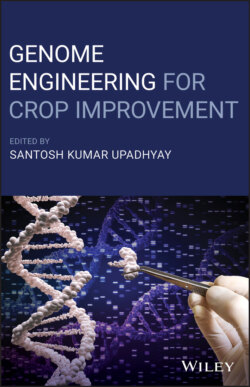Читать книгу Genome Engineering for Crop Improvement - Группа авторов - Страница 47
3.4.1 Rice
ОглавлениеRice (Oryzasativa L.) is a major cereal and a source of calories and protein to the vast population around the globe. It has a diploid genome (2n = 24); the small genome size makes it a model crop among monocots to investigate for research objectives (Fiaz et al. 2019). It has been reported that approximately, 499.37 million tons of rice was produced around the globe during year 2019 (FAO (Food and Agriculture Organization of The United Nations) Statistics 2017–18). The prime attributes influencing quality include cooking and eating, phytochemicals and micronutrients‐related characters (Lau et al. 2015). People from different ethnic groups and/or geographical regions have different grain‐quality preferences (Sabouri et al. 2012). Rice of premium quality like Indian basmati and Thai Jasmine are highly valued due to their typical aroma during cooking (Ferrero 2004). Rice grain quality parameters are very complex and easily affected by the environment. The key components which have impact on grain quality are (i) appearance quality (ii) milling quality (iii) eating‐cooking quality and (iv) nutritional quality which are further divided into many other categories (Lou et al. 2009). From the last few years, much research has demonstrated the successful application of CRISPR‐based targeted mutagenesis approach in rice to make efficient and reliable crop quality improvement.
Figure 3.1 Comparison of Gets. Classical methods include natural mutation via hybridization, induced mutation via physical agents (ultra violet; x‐ray and light), benzene analogs and chemical methods (nitrous acid). Site‐specific genome targeting technologies; (a) protein‐dependent DNA cleavage system TALE and ZFN (b) RNA‐dependent DNA cleavage, e.g. CRISPR‐Cas system (c) random mutation via error‐prone NHEJ or targeted mutation via error‐free HR. These approaches achieve genomic modification by inserting, deleting, or replacing targeted DNA sequence.
Source: Modified from Zhang et al. (Zhang et al. 2017).
Figure 3.2 The basic scheme of CRISPR/Cas system (Fiaz et al. 2019). (1a) Promoter fused with cas9 (1b) Promoter fused with sgRNA (2) Selection of target site from gene under investigation (3) tracrRNA hybridize and join the Cas9 (4) Cas9 vector containing gRNA attached with target sequence (5) Vector transformation; Detection of mutation and selection of desirable mutant plants (6) The mutant screening to get t‐DNA free plants and further analysis of phenotype in mutant plants.
Source: Modified from Fiaz et al. (Fiaz et al. 2019).
